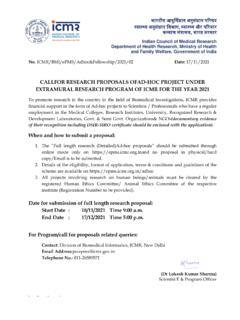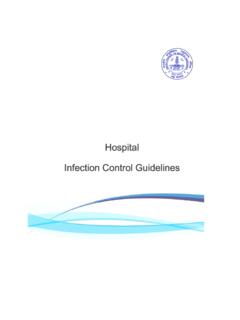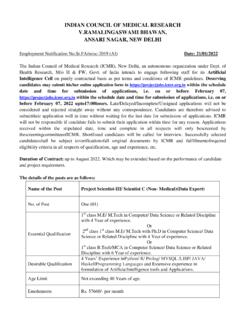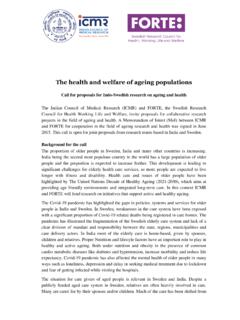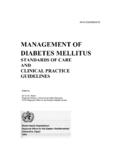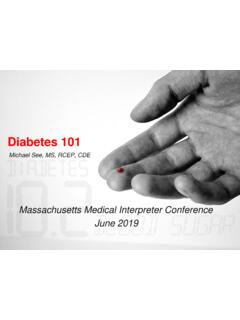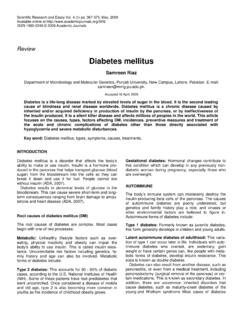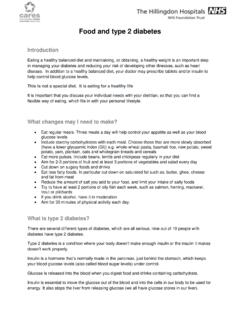Transcription of ICMR GUIDELINES FOR
1 ICMR GUIDELINES FORMANAGEMENT OF TYPE 2 DIABETES2018 Indian Council of Medical Research, Ansari Nagar,New Delhi 110 029 ICMR GUIDELINES for Management of Type 2 diabetes 2018 ICMR GUIDELINES FOR MANAGEMENT OF TYPE 2 diabetes SECTION 1 : of between type 1 and type 2 for diabetes of diabetes5 SECTION 2 : SCREENING FOR TYPE 2 and when to screen? to screen? to screen? aspects8 SECTION 3 : DIAGNOSTIC criteria for diabetes9 ICMR GUIDELINES for Management of Type 2 diabetes of for the diagnosis of Glucose Tolerance Test (OGTT) for type 2 diabetes in children and adolescents11 SECTION 4 : TARGETS FOR CONTROL OF for metabolic control in targets during pregnancy13 SECTION 5 : MONITORING AND FOLLOW-UP OF PEOPLE WITH to monitor and follow up people with diabetes ?
2 Monitoring with blood glucose (SMBG) with glucose to do during Annual check up15 SECTION 6 : NON-PHARMACOLOGICAL MANAGEMENT OF goals in Nutrition Therapy (MNT) activity and exercise and diabetes22 SECTION 7 : PHARMACOLOGICAL MANAGEMENT OF injectable therapy (GLP-1 receptor agonists)47 ICMR GUIDELINES for Management of Type 2 diabetes 2018 SECTION 8 : COMPLICATIONS OF artery foot57 SECTION 9 : diabetes AND diabetes mellitus (GDM) of hyperglycemia in follow up66 SECTION 10 : COMORBID 68 SUMMARY OF GUIDELINES69 ICMR GUIDELINES for Management of Type 2 diabetes 2018iICMR GUIDELINES for Management of Type 2 diabetes 2018iiICMR GUIDELINES for Management of Type 2 diabetes 2018iiiDr. Tanvir KaurScientist F Non Communicable DiseaseIndian Council of Medical ResearchICMR GUIDELINES for Management of Type 2 diabetes 2018ivPREAMBLE diabetes has become a global problem and the epidemic is most pronounced in South East Asia particularly India where an estimated 72 million people are believed to have diabetes and another 80 million have pre- diabetes .
3 More than 90 95% of all patients with diabetes have type 2 diabetes . The treatment of type 2 diabetes has undergone rapid changes in the last decade, and several new drugs have been introduced in the market. In 2005, the Indian Council of Medical Research (ICMR) brought out the GUIDELINES for Management of Type 2 diabetes as a small book and this has found wide application all over India. As more than a decade has elapsed since the publication of that document, ICMR felt that a revision of the GUIDELINES for Management of Type 2 diabetes was indicated. An expert group was constituted by ICMR, to look at the old GUIDELINES and to suggest modifications as may be needed, based on the latest developments in the management of type 2 diabetes . after several rounds of iteration, a document was prepared which was then circulated to a few additional experts. after getting the comments from these experts, an ICMR Workshop entitled ICMR GUIDELINES FOR MANAGEMENT OF TYPE 2 diabetes 2018 was held at Chennai on 10th January 2018 and a group of experts was invited by ICMR.
4 The Workshop was divided into different sections. Each part of the document was studied in detail and necessary changes were made to the document. The document was then placed in the ICMR website, giving an opportunity for anyone else who wished to view the documents and give their comments or suggestions to do so. A few additional suggestions were received which were also incorporated in the final document. We now have great pleasure in publishing the ICMR GUIDELINES for Management of Type 2 diabetes 2018 . We trust that this booklet will be useful not only for practicing physicians and general practitioners but also for medical students (both undergraduates and postgraduates) and also for nurses, educators and other paramedical personnel. We welcome feedback and suggestions from readers so that when the next set of GUIDELINES is prepared by ICMR, these suggestions can be incorporated.
5 We also wish to thank ICMR for their guidance and support and all the experts for the time and effort they spent in making this document. A special word of thanks to Dr. Ranjit Unnikrishnan who painstakingly compiled all the suggestions and comments and helped finalize the document. Dr. Nikhil Tandon,Professor & Head,Department of Endocrinology,All India Institute of Medical Sciences, Ansari Nagar, New DelhiDr. V. Mohan,Director,Madras diabetes Research Foundation & Dr. Mohan s diabetes Specialties Centre,4, Conran Smith Road, Gopalapuram Chennai ICMR GUIDELINES for Management of Type 2 diabetes 20181 SECTION 1 DefinitionDiabetes mellitus is a syndrome of multiple etiologies characterized by chronic hyperglycaemia with disturbances of carbohydrate, fat and protein metabolism resulting from defects in insulin secretion, insulin action or both. This disorder is often associated with long term complications, involving organs like eyes, kidneys, nerves, heart and blood EpidemiologyIn recent decades, India has witnessed a rapidly exploding epidemic of diabetes .
6 Indeed, India today has the second largest number of people with diabetes in the world. The International diabetes Federation (IDF) estimates that there are million people with diabetes in India in 2017, which is projected to rise to million by the year 2045. The prevalence of diabetes in urban India, especially in large metropolitan cities has increased from 2% in the 1970s to over 20% at present and the rural areas are also fast catching Types of diabetesAccording to the American diabetes Association and the World Health Organisation, diabetes can be classified into four main types (see Box).Classification of diabetes zType 1 diabetes zType 2 diabetes zGestational diabetes zOther types of diabetes (Monogenic diabetes , pancreatic diabetes , drug-induced diabetes etc.)ICMR GUIDELINES for Management of Type 2 diabetes 20182Of these, the two most important forms of diabetes are type 1 and type 2 diabetes .
7 Type 1 diabetes is primarily due to autoimmune-mediated destruction of pancreatic beta cells, resulting in absolute insulin deficiency and thus requiring insulin for good health and survival. While type 1 diabetes is also on the increase, the actual numbers of people with type 1 diabetes in India is, relatively speaking, still small. Type 2 diabetes , on the other hand, accounts for over 90-95% of all people with diabetes and is characterized by insulin resistance and abnormal insulin secretion, either of which may predominate. The diabetes epidemic relates particularly to type 2 diabetes , and predominantly due to the changing lifestyles, urbanization, demography and increased Differentiating Between Type 1 and Type 2 DiabetesTable below provides a few clinical points to differentiate between type 1 and type 2 Points to differentiate between type 1 and type 2 diabetesType 1 diabetesType 2 diabetesAge at diagnosisUsually childhood and adolescence, but can occur in adults as wellUsually postpubertal.
8 Most common in middle to later age groupsDiabetes in 1st degree relativeUnusualCommonSevere osmotic symptoms/ Ketosis at diagnosisCan occurRareMarkers of insulin resistanceAbsentPresentC-peptide assayAbsence of beta-cell reservePreserved beta-cell reservePancreatic autoantibodiesPresentAbsentICMR GUIDELINES for Management of Type 2 diabetes 20183 Type 1 diabetes will not be discussed further in these GUIDELINES and they pertain chiefly to type 2 diabetes . Type 2 diabetes is a metabolic-cum-vascular syndrome characterized by predominant insulin resistance with varying degrees of insulin secretory defect. It is a progressive disease often associated with central obesity, dyslipidaemia and hypertension. It is more common in overweight and obese individuals of middle to late age but is increasingly being seen in younger age groups and in those with lower body mass index (BMI) as well.
9 The Asian Indian phenotype refers to a peculiar constellation of abnormalities in south Asians, whereby for any given level of BMI, they tend to have higher total body fat, visceral fat, insulin resistance and prevalence of diabetes compared to white Caucasians (Figure ).Figure : The Asian Indian phenotype Lower threshold for BMI for diabetes Inflammatory markers; CRP Increased prevalence of type 2 diabetes / premature CVD Serum insulin levels/ insulin resistance ASIAN INDIAN PHENOTYPE w birth weight thin fat Indian Abdominal obesity and visceral fat Characteristic HDL cholesterol triglycerides & small dense LDL Levels of adiponectin Lower age at onset of Type 2 diabetes Greater ethnic susceptibility and genetic familial aggregation of type 2 diabetes dyslipidemia:LoICMR GUIDELINES for Management of Type 2 diabetes Goals for management zRelief from symptoms of diabetes and improvement in quality of life zGlycemic control and prevention of acute complications zIdentification and management of comorbid conditions like obesity, hypertension and dyslipidaemia zPrevention of microvascular complications like retinopathy, neuropathy and nephropathy zPrevention of macro-vascular complications like cardiovascular.
10 Cerebrovascular and peripheral vascular disease zPrevention of infectionsThe complete treatment of people with diabetes requires advocating a healthy life style with focus on increased physical activity and a proper balanced diet in addition to prescribing diabetes EducationDiabetes education means empowering people with diabetes with knowledge and providing tools crucial for making them active partners in the diabetes management team. These include: zIn-depth information about diabetes , its complications and treatment zAppropriate self care skills zAppropriate resources for self care zA positive attitude zSelf monitoring skillsThe compliance of people with diabetes is essential for effective management of diabetes . Education programmes are intended to help people to understand why these actions are so important and thereby increase their motivation for GUIDELINES for Management of Type 2 diabetes Prevention of DiabetesThere is an urgent need for strategies to prevent or at least slow down the emerging epidemic of diabetes apart from treating diabetes and associated complications.
